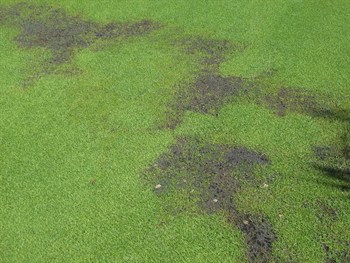Origins of sulfur forms on turf and consequences.

A few nice stories about Sulfate Sulfur on turf.
What happens in reality?
First, we all must ask ourselves the following questions:
"What are the needs of turf grasses in the element sulfur?"
"How many are there in a long ground normally?"
"How much do we provide the fertilizer?"
"What’s the others sources of input?"
The available information on quantifying sulfur in turf grasses is very poor.
We can still reason about the fact that the grass "export" by mowing to about 25 to 60 Kg / ha / year depending on the species. (Source INRA. Report in May 1974. Lusignan).
These measures may seem a little out of date, but despite the development of varieties should not have changed a lot ...
How is Sulfur brought on the sports fields?
Just a reminder of fertilization…
A good fertilization is a balanced one.
Contributions by the soil and air on a lawn:
By the atmosphere between 15 and 60 kg / ha / year from the area and the degree of pollution from fossil fuels (coal and hydrocarbons). (Acid Rain)
The ground: by mineralization of organic sulfur (15 to 40 kg / ha / year) (D. Soltner)
Supplementation with fertilizers containing Potassium sulfate, Ammonium sulfate and Magnesium sulfate.
For Example:
A case with a granulated product base sulfates: NPK 20.5.10+2 containing 17% SO3, 13% water soluble. Recommendation of the manufacturer of sports field: between 2000 and 2500 kg / ha / year (Very high level of nutrition) and sulfur intake from 340 to 425 Kg / ha / year (between 5.5 and 7 times the annual needs ...) (Excluding contributions from the atmosphere or the ground itself).
Case with a product mix granulated base sulfate + sulfur (like sulfur coat)
We must also add the 20% sulfur mineral that contains the coating is to provide 400 units of nitrogen, gives 1100 kg / ha / year urea 36% or 207 kg sulfur / ha / year ... Combined with the contribution of potash, magnesia see also ammonium sulfate, we will therefore at about 600 kg / ha / year of sulfur in various forms in most of the small 50 kg on average provided by the pollution air and soil. About 11 times the needs of the grass by the standards of INRA.
The surplus will therefore be naturally accumulated in the soil, or end up in the drainage water. In the best case, the grass will grow just the amount of effluent into surface water...
And other elements?
It is not possible to coat other nutrients with sulfur. There is no difference between P and K "agricultural" and those in a formulation or SCU PSCU. They are a “quick” release ... It can therefore be determined that only one hand nitrogen nutrition is sustained release, therefore the plant will receive 3 to 4 times a year the other elements it is true less leachable (Except sandy soil).
Yes, but the sulfur can acidify the soil!
In fact, often confused (and some confusion let grow on sulfur would be acidifying ...).
On the one hand, it is not so obvious that the species used require acidic pH (we find many bluegrass and English ryegrass, soil rather slightly basic).
Also, when talking to acidify with a mineral with sulfur rather than sulfate, is immobilized one of the oxygen in the soil which has the effect of accentuating the phenomenon of Black Layer and the asphyxiation in general.
It also requires a very large amount of sulfur to acidify the soil (> 3000 u / year to reduce the pH of 0.5). Knowing that a sprinkling of 35 mm with a hardness of 25 ° TH is sufficient to neutralize the sulfur.
Finally, the Black Layer only appears on the occurrence of sulfur, because of this as the "decalcification” soil with sulfur, although it is relatively small, contributing with its anaerobic action, promote the formation of the black layer and especially the appearance at certain times of the year H2S gas, toxic for the turf.


